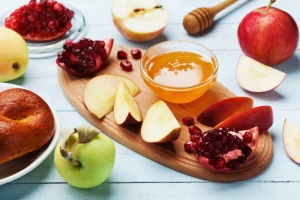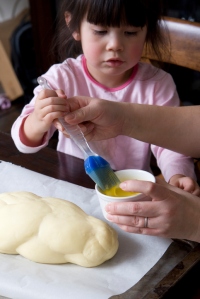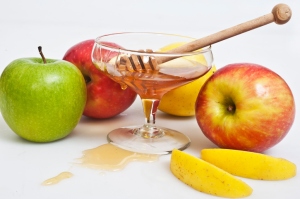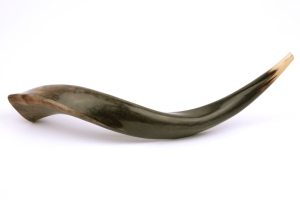The beginning of the school year signals the beginning of many things: meeting new children and families, observing children becoming friends, setting rules and expectations, implementing new ideas and activities—the list goes on. It’s fitting, then, that Rosh Hashanah, the Jewish New Year, occurs during September. Rosh Hashanah literally translates to “Head of the Year.” (For help pronouncing Jewish holidays and Hebrew words, search here.) In addition to praying and attending services, Rosh Hashanah is a time when Jewish people reflect on their feelings and actions and consider how they may enter the new year with the best of intentions.
 Like most holidays, Rosh Hashanah is associated with certain symbols, all of which can be used to inspire extended activities. Symbols of Rosh Hashanah include apples, honey, challah, pomegranates, and the shofar, a horn that is sounded following the reading of the Torah and services. Apples and honey are perhaps the most well-known symbol to those outside Judaism—they are consumed as way of welcoming a sweet year. Challah is generally baked as a round loaf during Rosh Hashanah to symbolize the circle of time and may also be dipped in honey. Pomegranate seeds represent abundance, or at least the wish for it, and the shofar, a ram’s horn, is sounded as a call for repentance but also a welcoming of God as king of the universe. Those less familiar with Rosh Hashanah shouldn’t feel overwhelmed about bringing the holiday into their classrooms. Here are several easy ways to integrate it into your September activities and make it accessible for families.
Like most holidays, Rosh Hashanah is associated with certain symbols, all of which can be used to inspire extended activities. Symbols of Rosh Hashanah include apples, honey, challah, pomegranates, and the shofar, a horn that is sounded following the reading of the Torah and services. Apples and honey are perhaps the most well-known symbol to those outside Judaism—they are consumed as way of welcoming a sweet year. Challah is generally baked as a round loaf during Rosh Hashanah to symbolize the circle of time and may also be dipped in honey. Pomegranate seeds represent abundance, or at least the wish for it, and the shofar, a ram’s horn, is sounded as a call for repentance but also a welcoming of God as king of the universe. Those less familiar with Rosh Hashanah shouldn’t feel overwhelmed about bringing the holiday into their classrooms. Here are several easy ways to integrate it into your September activities and make it accessible for families.
- Review classroom rules and expectations. Ask the children to list ways they can meet these expectations (e.g., How can we stay safe? Possible answers: We can remember to share, be kind to each other, remind friends to use inside feet, etc.). Write down what they say and post the list in your room. Explain that remembering the rules will help everyone kick off the new year with a good start.
- Bake challah.
 Invite the children to help you prepare the ingredients. Cut small sections of dough and give each child a piece to roll out her own mini loaves. Demonstrate how to roll the dough like a snake and wind it up like a spiral or snail shape. Here, you can talk with the children about why the challah is round, discuss other items that are round or spiral like, or even use it as a segue for discussing bakers and other community helpers.
Invite the children to help you prepare the ingredients. Cut small sections of dough and give each child a piece to roll out her own mini loaves. Demonstrate how to roll the dough like a snake and wind it up like a spiral or snail shape. Here, you can talk with the children about why the challah is round, discuss other items that are round or spiral like, or even use it as a segue for discussing bakers and other community helpers.
- Sample apples, pomegranates, or any fruit of interest to the children. Bring in a variety of apples (red, yellow, green, Granny Smith, Red Delicious, Pink Lady, etc.) for the children to try. First discuss how they are visually similar and different. Have the children make predictions about how each apple will taste. Make a graph and vote on their favorites afterward. How many of your children have tried pomegranates? Isn’t it strange that we eat the seeds instead of the flesh? Cutting and eating a pomegranate is an experience in and of itself for small children. You can also serve the seeds on top of plain or vanilla yogurt. Invite the children to make guesses about how many seeds are inside a single pomegranate. Write down what they say and count the seeds together. Cut open and display a pomegranate and encourage the children to draw what they see. Talk about and display their observations. Replicate any of these activities with other fruits of interest to the children.

- Dip challah and fruit in honey. Talk about bees and other pollinators. Just like apples, honey comes in many varieties—clover, buckwheat, acacia, etc. Why are there so many types of honey? Is it because of the types of plants the bees pollinated or where the plants and bees are located? Is honey always the same color? Bring in samples of a few types of honey. Talk with children about what they see. Let them sample some and ask them how each variety tastes. Use a food cycle infographic or a diagram that you draw to explain the honey-making process and talk about the parts of bee and the bee life cycle. Introduce other pollinators like butterflies, moths, and flies. Diagram the parts of a flower. Invite a beekeeper to your classroom if there is an apiary nearby.
- Make shofars.
 Print and share pictures of shofars with the children. Talk about its significance as an instrument of welcoming and celebration. Use paper plates and yarn or party horns and construction paper to make shofars with the children and blow them to welcome the New Year (see here and here for instructions). Practice playing the shofars loudly and quietly and fast and slow. If possible, contact synagogues in your area to see if a congregant would be interested in visiting your classroom and playing a shofar for the children.
Print and share pictures of shofars with the children. Talk about its significance as an instrument of welcoming and celebration. Use paper plates and yarn or party horns and construction paper to make shofars with the children and blow them to welcome the New Year (see here and here for instructions). Practice playing the shofars loudly and quietly and fast and slow. If possible, contact synagogues in your area to see if a congregant would be interested in visiting your classroom and playing a shofar for the children.
Resources like PJ Library and Chabad.org offer additional information and activities about Rosh Hashanah and other Jewish holidays. Supplement these activities with the following books:
Infants and Toddlers
It’s Shofar Time! by Latifa Berry Kropf
Happy Birthday, World: A Rosh Hashanah Celebration by Latifa Berry Kropf
Rosh Hashanah is Coming by Tracy Newman
Apples and Honey by Joan Holub
Preschool
Is It Rosh Hashanah Yet? by Chris Barash
Little Red Rosie by Eric A. Kimmel
Are We Still Friends? by Ruth Horowitz
Sammy Spider’s First Rosh Hashanah by Sylvia Rouss
How the Rosh Hashanah Challah Became Round by Sylvia B. Epstein
Like any holiday, Rosh Hashanah is a time for gathering and family. Consider inviting parents and caregivers into the classroom for a Rosh Hashanah tasting if you bake challah and offer fruit and honey or to hear a special guest. If you have Jewish children in your classroom, ask their parents or caregivers if they would be interested in doing a holiday activity with your class or sharing with the children how they celebrate. When offering food, remember to keep children’s allergies in mind and to offer smaller bites or purees to infants and toddlers and to seek parent/guardian permission (children under age one should not consume honey).
When all is said and done, wish everyone a “good year,” or say in Hebrew, Shana Tova!
Back to blog listing